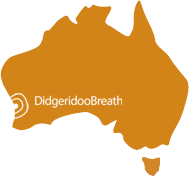Sheet music for didgeridoo? Not something that exists yet as a standard amongst didgeridoo players. This is probably due to the didgeridoo being so unique to the individual. In fact it’s one of the beautiful things about the instrument, there are no rules.
Having said that, it is possible to write down your didgeridoo sounds and rhythms and it comes in really handy when trying to communicate your favorite rhythms to others. We used this technique in the Playing the Didgeridoo instructional CD series to write all of the rhythms taught, in the booklets provided.
Here is a guide to get you going. Feel free to add your own flavor to it or customize it to your needs.
What means what?
First of all, you need a legend or key so you know what symbols mean what sound/technique. You can make up your own or use some of these examples:
| Symbol | Technique |
| B | Circular Breath |
| dar | miming (without your voice) the word “dar” |
| dee | miming (without your voice) the word “dee” |
| ha | diaphragm pulse, like a little cough |
| ee | a sharper harmonic sound made by moving your tongue forward. |
| GA | a short vocal sound like a dog bark |
… you get the idea. Attach a symbol that makes sense to you, to each of your different sounds.
Building the rhythm
So now we need some timing or a beat to play to. Think of clapping your hands, tapping some clap sticks or a beat on the drum…even timing, like the second hand on a clock.
If you have a metronome you can play that, if you have any of the Playing The Didgeridoo CDs, you can use the clap stick tracks at the end of each CD.
So to write the beat would be like…
| 1 | 2 | 3 | 4 |
Each number is a beat. You can make the beat any speed you wish, but to start with keep it slow and simple.
Now we can “plug in” our didgeridoo sounds into the beats.
Ok, grab your didge, get your beat going and get ready to play.
Firstly, the most important sound/technique is the breath. It’s what will allow us to keep this rhythm going. So you need to make the breath a part of every didgeridoo rhythm. It doesn’t matter if you can’t do the circular breathing yet, just take a sniff on the breaths.
Here are 4 rhythms that we teach on Playing the Didgeridoo CD #1 – Beginner Techniques
So now for our first rhythm…
| 1 | 2 | 3 | 4 |
| dar | dar | dar | B |
Lets add a sound change…
| 1 | 2 | 3 | 4 |
| dar | dar | dee | B |
Now add a vocal sound…
| 1 | 2 | 3 | 4 |
| dar | GA | dar | B |
Some diaphragm
| 1 | 2 | 3 | 4 |
| dar | ha | dar | B |
Making sense?
You can go crazy and come up with as many simple or complex rhythms as you wish.
Good luck with the practice and let us know if you have any questions.
Maybe we could establish a global didgeridoo notation guide for us to share our favorite rhythms.
Enjoy!
If you are getting the hang of the straight 4-beat timing… you can try mixing up the counting. Sanshi talks us through different couting in this video:






